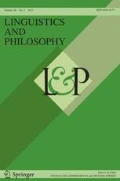Abstract
I propose the first strictly compositional semantic account of same. New data, including especially NP-internal uses such as two men with the same name, suggests that same in its basic use is a quantificational element taking scope over nominals. Given type-lifting as a generally available mechanism, I show that this follows naturally from the fact that same is an adjective. Independently-motivated assumptions extend the analysis to standard examples such as Anna and Bill read the same book via a mechanism I call PARASITIC SCOPE, in which the scope of same depends on the scope of some other scopetaking element in the sentence. Although I will initially discuss the analysis in terms of a familiar Quantifier Raising framework, I go on to implement the analysis within an innovative continuation-based Type-Logical Grammar. The empirical payoff for dealing in continuations is that a simple generalization of the basic analysis gives the first ever formal account of cases in which same distributes over objects other than NP denotations, as in the relevant interpretation of John hit and killed the same man.
Similar content being viewed by others
References
Barker C. (1998). Individuation and quantification. Linguistic Inquiry 30(4): 683–691
Barker C. (2002). Continuations and the nature of quantification. Natural Language Semantics 10(3): 211–242
Barker, C. (2004). Continuations in natural language. In H. Thielecke (Ed.), Proceedings of the Fourth ACM SIGPLAN Continuations Workshop (CW’04). Technical Report CSR-04-1, School of Computer Science, University of Birmingham, Birmingham B15 2TT, United Kingdom, pp. 1–11.
Barker, C. (2007). Direct compositionality on demand. In C. Barker, & P. Jacobson (Eds.), Direct compositionality (pp. 102–131). Oxford University Press.
Barker C., Shan C.-C. (2006). Types as graphs: Continuations in type-logical grammar. Journal of Logic, Language, and Information 15(4): 331–370
Barker, C., & Shan, C.-C. (In prep). Reasoning about contexts in Lambek grammar.
Barwise J., Cooper R. (1981). Generalized quantifiers in natural language. Linguistics and Philosophy 4, 159–200
Beck S. (2000). The semantics of different: Comparison operator and relational adjective. Linguistics and Philosophy 23, 101–139
Bernardi, R., & Moortgat, M. (2007). Continuation semantics for symmetric categorial grammar. In D. Leivant, & R. de Queiros (Eds.), Proceedings 14th Workshop on Logic, Language, Information and Computation (WoLLIC’07), LNCS 4576. Springer, 2007.
Carlson G. (1987). Same and different: Some consequences for syntax and semantics. Linguistics and Philosophy 10(4): 531–565
Dekker P. (2003). Meanwhile, within the Frege Boundary. Linguistics and Philosophy 26(5): 547–556
Dotlacil, J., & Nilsen, O. (2007). Expressions of non-identity in Dutch. Ms.
Dowty, D. (1985). A unified indexical analysis of same and different: A response to Stump and Carlson. Paper Presented at University of Texas Workshop on Syntax and Semantics, Austin, Texas, March 22–24, 1985.
van Eijck, J. (2003). Relations, types and scoping. Slides.
van Eijck, J. (2004). Normal forms for characteristic functions on n-ary relations. Ms.
de Groote, P. (2001). Continuations, type raising, and classical logic. In R. van Rooy, &M. Stokhof (Eds.), Thirteenth Amsterdam Colloquium (pp. 97–101). Institute for Logic, Language and Computation, Universiteit van Amsterdam.
Hackl, M. (2001). Comparative quantifiers. PhD Dissertation, MIT.
Heim, I. (1985). Notes on comparatives and related matters. Ms. (Available at semanticsarchive.net.)
Heim I., Kratzer A. (1998). Semantics in generative grammar. Oxford, Blackwell
Hendriks, H. (1993). Studied flexibility. ILLC Dissertation Series. Amsterdam.
Jacobson P. (1999). Towards a variable free semantics. Linguistics and Philosophy 22, 117–184
Keenan E. (1992). Beyond the Frege Boundary. Linguistics and Philosophy 15(2): 199–221
Keenan E., Faltz L. (1985). Boolean semantics for natural language. Dordrecht, D. Reidel
Krifka M. (1990a). Four thousand ships passed through the lock: object-induced measure functions on events. Linguistics and Philosophy 13, 487–520
Krifka M. (1990b). Boolean and non-Boolean And. In L.Kálman, & L. Polos (Eds.), Papers from the Second Symposium on Logic and Language. Akadémiai Kiadó, 1990, Budapest, pp. 161–188.
Lambek J. (1958). The mathematics of sentence structure. American Mathematical Monthly 65, 154–170
Lasersohn, P. (2000). Same, models and representation. Proceedings of Semantics and Linguistic Theory, 10.
Moltmann F. (1992). Reciprocals and same/different: Towards a semantic analysis. Linguistics and Philosophy 15(4): 411–462
Moortgat M. (1997). Categorial type logics. In: van Benthem J., ter Meulen A. (eds). Handbook of logic and language. Cambridge, MIT Press, pp. 93-177
Nunberg G. (1984). Individuation in context. Proceedings of the West Coast Conference on Formal Linguistics 2, 203–217
Oehrle, R. (1996). Austinian pluralities. In J. Seligman, & D. Westerstahl (Eds.), Language, logic, and computation (pp. 433–441). Stanford, CSLI: distributed by Cambridge University Press.
Parson T. (1990). Events in the semantics of English. A study in subatomic semantics. Cambridge, MIT Press
Partee, B. H. (1987). Noun phrase interpretation and type-shifting principles. In J. Groenendijk, D. de Jongh, & M. Stokhof (Eds.), Studies in discourse representation theory and the theory of generalized quantifiers (pp. 115–143). Foris.
Partee B.H., Rooth M. (1983). Generalized conjunction and type ambiguity. In: Bäuerle R., Schwarze C., von Stechow A. (eds). Meaning, use, and interpretation of language. Berlin, Walter de Gruyter, pp. 361-383
Restall, G. (2000). An introduction to substructural logics. Routledge.
Sauerland, U. (1998). Plurals, derived predicates and reciprocals. In U. Sauerland, & O. Percus (Eds.), The interpretive tract. MIT Working Papers in Linguistics, 25, 177–204.
Schwarzschild R. (1996). Pluralities. Dordrecht, Kluwer
Shan C.-C., Barker C. (2006). Explaining crossover and superiority as left-to-right evaluation. Linguistics and Philosophy 29(1): 91–134
Steedman M. (2000). The syntactic process. Cambridge, MIT Press
Stump, G. (1982). A GPSG fragment for ‘dependent nominals’. Unpublished Ohio State University Paper.
Tovena, L., & Van Peteghem, M. (2002). Facets of ‘different’ in French: différent and autre. In C. Beyssade, et al. (Eds.), Actes de CSSP 2001: Empirical issues in formal syntax and semantics. Paris: Presses Universitaires de la Sorbonne.
Author information
Authors and Affiliations
Corresponding author
Additional information
Thanks to Sigrid Beck, Peter Lasersohn, Dick Oehrle, Chung-chieh Shan, Ede Zimmermann, two wonderfully insightful anonymous referees, and audiences at SALT 14 and Stanford.
Rights and permissions
About this article
Cite this article
Barker, C. Parasitic scope. Linguist and Philos 30, 407–444 (2007). https://doi.org/10.1007/s10988-007-9021-y
Received:
Accepted:
Published:
Issue Date:
DOI: https://doi.org/10.1007/s10988-007-9021-y




